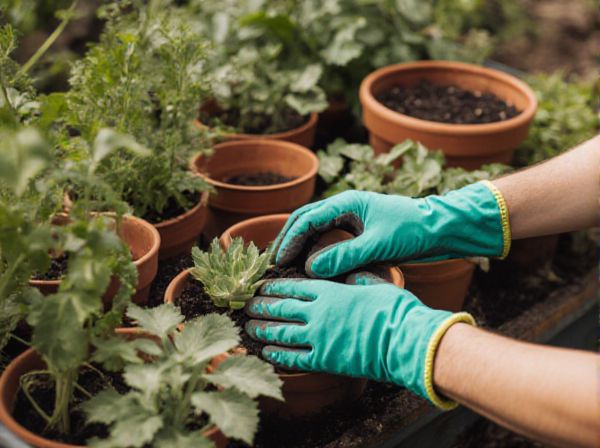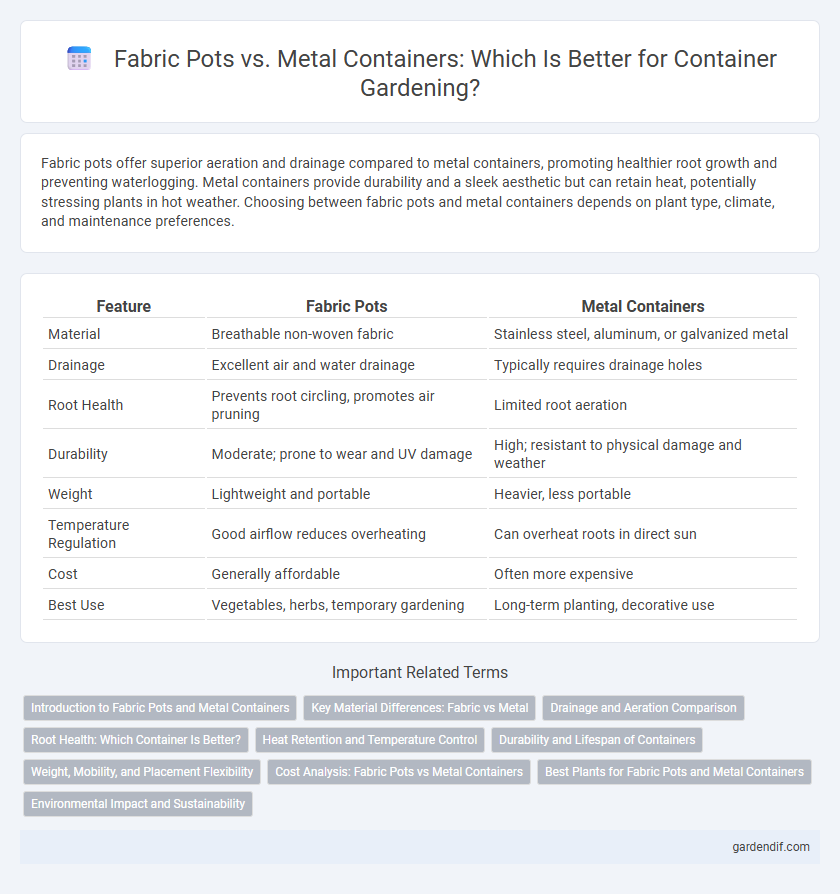
Fabric pots vs metal containers Illustration
Fabric pots offer superior aeration and drainage compared to metal containers, promoting healthier root growth and preventing waterlogging. Metal containers provide durability and a sleek aesthetic but can retain heat, potentially stressing plants in hot weather. Choosing between fabric pots and metal containers depends on plant type, climate, and maintenance preferences.
Table of Comparison
| Feature | Fabric Pots | Metal Containers |
|---|---|---|
| Material | Breathable non-woven fabric | Stainless steel, aluminum, or galvanized metal |
| Drainage | Excellent air and water drainage | Typically requires drainage holes |
| Root Health | Prevents root circling, promotes air pruning | Limited root aeration |
| Durability | Moderate; prone to wear and UV damage | High; resistant to physical damage and weather |
| Weight | Lightweight and portable | Heavier, less portable |
| Temperature Regulation | Good airflow reduces overheating | Can overheat roots in direct sun |
| Cost | Generally affordable | Often more expensive |
| Best Use | Vegetables, herbs, temporary gardening | Long-term planting, decorative use |
Introduction to Fabric Pots and Metal Containers
Fabric pots offer superior aeration and drainage, promoting healthy root growth and preventing overwatering issues common in traditional metal containers. Metal containers provide durability and resistance to environmental stress but may cause heat retention that can damage plant roots. Both container types serve specific purposes, with fabric pots favored for plant health and metal containers valued for longevity and structural strength.
Key Material Differences: Fabric vs Metal
Fabric pots offer superior breathability and drainage compared to metal containers, promoting healthier root aeration and preventing waterlogging. Metal containers excel in durability and heat retention but may cause root overheating and reduced oxygen flow. The choice between fabric and metal hinges on balancing the benefits of moisture control and temperature regulation for optimal plant growth.
Drainage and Aeration Comparison
Fabric pots provide superior drainage and aeration compared to metal containers due to their porous material, allowing excess water to escape and air to circulate freely around plant roots, reducing the risk of root rot. Metal containers often retain water and limit airflow, creating a less oxygen-rich environment that can inhibit root growth and promote fungal diseases. Choosing fabric pots enhances root health by maintaining optimal moisture levels and preventing soil compaction through improved aeration.
Root Health: Which Container Is Better?
Fabric pots promote superior root health by allowing air pruning, which prevents root circling and encourages a dense, fibrous root system. Metal containers can cause heat buildup and poor aeration, leading to root stress and inhibited growth. For optimal root development and prevention of root-bound conditions, fabric pots are the better choice.
Heat Retention and Temperature Control
Fabric pots provide superior temperature regulation for plants by allowing better airflow and heat dissipation compared to metal containers, which tend to retain heat and can cause root overheating. The breathable nature of fabric pots prevents soil from becoming excessively warm, promoting healthier root systems and preventing heat stress. In contrast, metal containers absorb and radiate heat quickly, leading to higher soil temperatures that may damage delicate plant roots.
Durability and Lifespan of Containers
Fabric pots offer excellent breathability and flexibility but generally have a shorter lifespan, lasting 1 to 3 years due to material degradation from UV exposure and frequent watering. Metal containers boast superior durability and longevity, often exceeding 10 years, as they resist weathering and physical damage, though they may be prone to rust if not properly treated. Choosing between fabric pots and metal containers depends on the required lifespan and exposure conditions in the gardening or shipping environment.
Weight, Mobility, and Placement Flexibility
Fabric pots offer significantly lighter weight compared to metal containers, enhancing easy mobility for frequent repositioning. Their flexible structure allows placement in tight or irregular spaces, unlike rigid metal containers that limit placement options. While metal containers provide durability, the lightweight and adaptability of fabric pots make them ideal for dynamic gardening setups requiring mobility and flexible placement.
Cost Analysis: Fabric Pots vs Metal Containers
Fabric pots generally offer a more cost-effective solution compared to metal containers, with prices often ranging from $5 to $20 depending on size and material quality, while metal containers can cost upwards of $30 to $100 or more due to durability and design. Fabric pots provide flexibility and lightweight handling, reducing shipping and transportation expenses, whereas metal containers may incur higher upfront costs but potentially offer longer lifespan and reuse potential. When analyzing long-term cost efficiency, fabric pots tend to be budget-friendly for short to medium-term use, while metal containers may present a better investment for heavy-duty or permanent applications.
Best Plants for Fabric Pots and Metal Containers
Fabric pots are ideal for growing root vegetables like carrots, potatoes, and herbs due to their excellent aeration and drainage that prevent root rot. Metal containers suit heat-tolerant plants such as succulents, cacti, and Mediterranean herbs because metal retains warmth, promoting faster growth in cooler climates. Both container types support a wide range of vegetables and flowers, but selecting based on plant water and temperature needs maximizes growth success.
Environmental Impact and Sustainability
Fabric pots reduce environmental impact by using breathable, reusable materials that promote healthier root growth and decrease soil erosion compared to metal containers, which often require energy-intensive mining and manufacturing processes. The biodegradable nature of many fabric pots supports sustainability through lower landfill contributions and easier recycling, whereas metal containers, although durable, may involve significant carbon emissions during production and disposal. Choosing fabric pots fosters eco-friendly gardening practices by minimizing resource consumption and enhancing plant vitality.
Fabric pots vs metal containers Infographic

 gardendif.com
gardendif.com